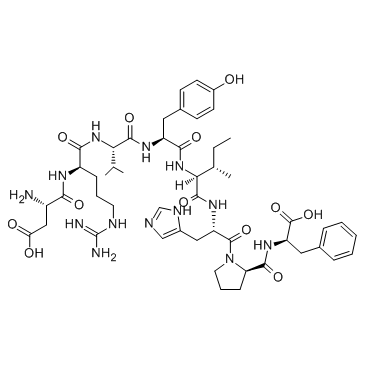All AbMole products are for research use only, cannot be used for human consumption.

In vitro: Most of the known actions of Angiotensin II (Ang II) are mediated by AT1 receptors, the AT2 receptor contributes to the regulation of blood pressure and renal function. Angiotensin II raises blood pressure (BP) by a number of actions, the most important ones being vasoconstriction, sympathetic nervous stimulation, increased aldosterone biosynthesis and renal actions. Other Angiotensin II actions include induction of growth, cell migration, and mitosis of vascular smooth muscle cells, increased synthesis of collagen type I and III in fibroblasts, leading to thickening of the vascular wall and myocardium, and fibrosis. These actions are mediated by type 1 Ang II receptors (AT1). At the cellular level, responsiveness to Angiotensin II is conferred by the expression of the two classes of angiotensin receptors (AT1 and AT2). The effects of Angiotensin II to increase blood pressure are mediated by AT1 receptors.
In vivo: To distinguish the AT1 receptor population that is critical for the pathogenesis of hypertension, osmotic minipumps are implanted s.c. into each animal to infuse Angiotensin II (1,000 ng/kg/min) continuously for 4 weeks. Angiotensin II causes hypertension by activating AT1 receptors in the kidney promoting sodium reabsorption.

Mol Nutr Food Res. 2025 Jan 31.
Chlorogenic Acid Ameliorates Chronic Unpredictable Stress-Induced Diminished Ovarian Reserve Through Ovarian Renin-Angiotensin System
Angiotensin II human purchased from AbMole

Patent. CN119679916A 2025 Mar 25.
Patent. CN119679916A
Angiotensin II human purchased from AbMole

Acta Pharmacol Sin. 2024 Jan.
Endothelial cell Orai1 is essential for endothelium-dependent contraction of mouse carotid arteries in normotensive and hypertensive mice
Angiotensin II human purchased from AbMole

BMC Cardiovasc Disord. 2024 Feb;24(1):106.
Sacubitril/valsartan inhibits the proliferation of vascular smooth muscle cells through notch signaling and ERK1/2 pathway
Angiotensin II human purchased from AbMole
| Cell Experiment | |
|---|---|
| Cell lines | |
| Preparation method | |
| Concentrations | |
| Incubation time | |
| Animal Experiment | |
|---|---|
| Animal models | (129×C57BL/6) F1 mice lacking AT1A receptors for Angiotensin II |
| Formulation | - |
| Dosages | 1,000 ng/kg/min |
| Administration | implanted s.c. |
| Molecular Weight | 1046.18 |
| Formula | C50H71N13O12 |
| CAS Number | 4474-91-3 |
| Solubility (25°C) | Water 5 mg/mL DMSO |
| Storage | -20°C, protect from light, sealed |
| Related Animal Modeling Products |
|---|
| 3,4-Benzopyrene
3,4-Benzopyrene shows lung carcinogenicity in animal models. |
| Sodium Thioglycolate
Sodium thioglycolate acts as reducing agent and is suitable for anaerobic and microaerophilic bacterial growth. Sodium thioglycolate is a commonly used reagent for bacteriological research to maintain reducing conditions in media. Thioglycolate can also protect enzymes against inactivation by maintaining protein thiol groups in the reduced state. Thioglycolate medium is frequently used in inflammation research to elicit a neutrophil and macrophage response in vivo. |
| Vancomycin-d10 2TFA salt
Vancomycin-d10 2TFA salt |
| Acetic acid-d4
Acetic acid-d4 |
| Myosin H Chain Fragment, mouse acetate
Myosin H Chain Fragment, mouse acetate salt is a fragment of the α-Myosin heavy chain peptide. Myosin H Chain Fragment can be used to induce experimental autoimmune myocarditis (EAM) mouse model. |
All AbMole products are for research use only, cannot be used for human consumption or veterinary use. We do not provide products or services to individuals. Please comply with the intended use and do not use AbMole products for any other purpose.


Products are for research use only. Not for human use. We do not sell to patients.
© Copyright 2010-2024 AbMole BioScience. All Rights Reserved.
